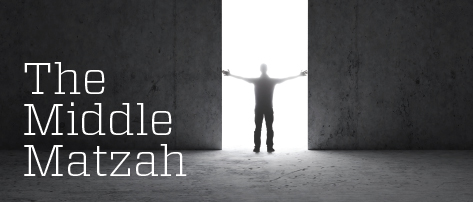The fourth step of the Pesach seder is “Yachatz”, breaking the middle matzah. When we break the matzah, each piece gets its own, opposing identity. The smaller piece is the “poor man’s bread”, while the larger becomes the Afikoman, a symbol of the Paschal lamb. The smaller, humble piece, over which we recount our slavery and exile, remains on the table under the seder plate, while the Afikoman, the symbol of redemption, is hidden out of sight.
A glaring question arises. How can one simple matzah embody two dynamic, fundamentally opposite “personalities”? The fifth Lubavitcher Rebbe, Rabbi Sholom DovBer (the RaSHaB), answers this question with a story of the Ba’al Shem Tov:
Yisroel Ba’al Shem Tov, the founder of Chassidism, sometimes signed his name as “Yisroel from Okop”. Okop is not the name of the town where the Ba’al Shem Tov lived. He actually was born in the town of Tlost, rather Okop means “trench” in Polish.
Tlost was originally a walled town, but at some point in history the walls were destroyed, leaving numerous trenches. The Ba’al Shem Tov’s parents were so poor that they could not even afford the most basic home and lived in the trenches. The Ba’al Shem Tov was born in one of these trenches, and hence signed his name “Yisroel from Okop”.
In the sefer Kesser Shem Tov, the Ba’al Shem Tov states that while he is not actually Moshiach, his Chassidic movement will ultimately be responsible for bringing Moshiach. So, after telling this story, the Rebbe RaSHaB would add, “From the Ba’al Shem Tov’s trenches we have been granted the strength to get out of all other trenches, for the Ba’al Shem Tov’s influence is unfaltering.”
The irony here is enormous. The Ba’al Shem Tov, who is responsible for influencing the Jewish world and eventually bringing in the Era of Redemption through his teachings, started his life in a trench! This irony and disparity is the whole point. As Dovid HaMelech wrote in Tehillim (118:5): “Out of the straits I called upon G-d; G-d answered me with expansiveness.” The expanse can only come after we have been squeezed through the smallest space.
This is the essence of the middle matzah. Slavery and redemption, poverty and wealth, both come from the same piece of matzah. Light follows darkness, hope follows despair, triumph follows tragedy.
Even though our current reality is full of darkness and concealment, even though we cannot see the solution to the problems in our world, Moshiach is waiting right around the corner, the other half of the matzah, and we will soon be pulled from our trenches of Golus and into the final Geula by our righteous Moshiach.
(Adapted from a sicha of the Lubavitcher Rebbe from the 2nd night of Pesach 5720.)







